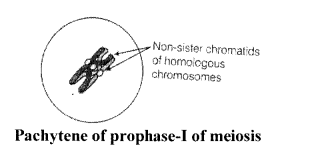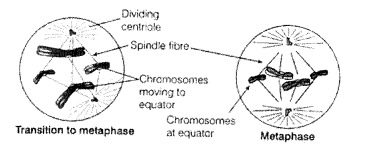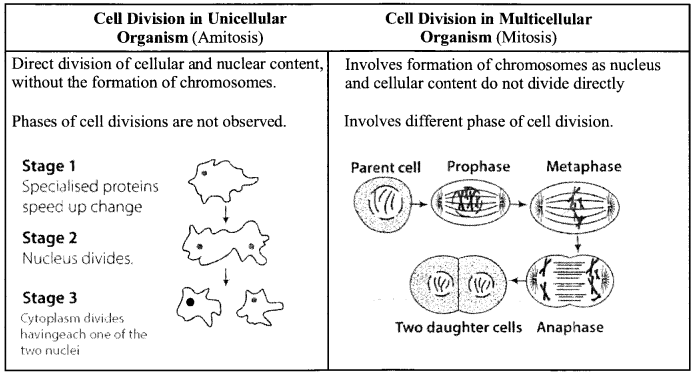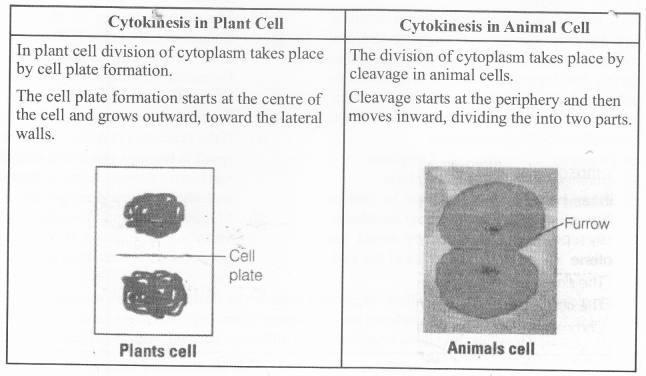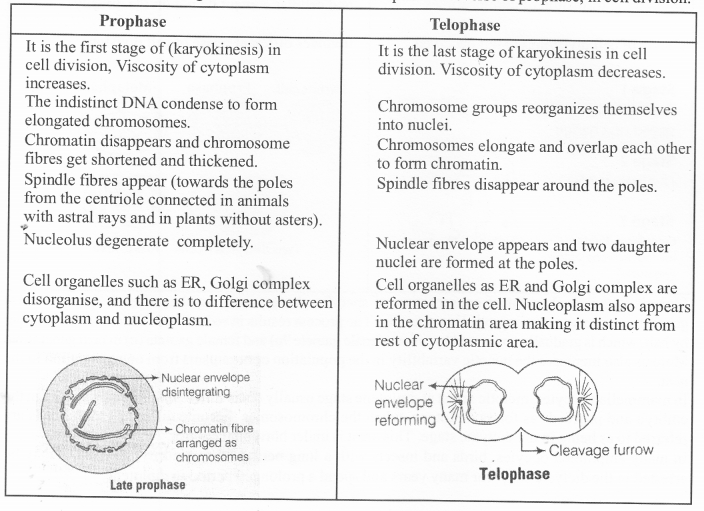NCERT Solutions for Class 11 Biology Chapter 10 Cell Cycle and Cell Division
These Solutions are part of NCERT Solutions for Class 11 Biology. Here we have given NCERT Solutions for Class 11 Biology Chapter 10 Cell Cycle and Cell Division.
Question 1.
What is the average cell cycle span for a mammalian cell?
Solution:
It is significant to note that in the 24-hour average duration of the cell cycle of a human cell or mammalian cells, cell division proper lasts for only about an hour.
Question 2.
Distinguish cytokinesis from karyokinesis.
Solution:
- Karyokinesis is a division of the nucleus (mitosis or meiosis) while cytokinesis is a division of the cytoplasm.
- Cytokinesis in an animal cells is achieved by the appearance of a furrow in the plasma membrane.
- The furrow gradually deepens and ultimately joins in the center dividing the cell cytoplasm into two.
- In-plant cell cell wall formation starts in the center of the cell and grows outward to meet the existing lateral walls.
- The formation of a new cell wall begins with the formation of a simple precursor, called the cell plate that represents the middle lamella between the walls of two adjacent cells.
- It is the time of cytoplasmic division, organelles like mitochondria and plastids get distributed between the two daughter cells.
- In some organisms, karyokinesis is not followed by ”cytokinesis as a result of which multinucleate condition arises leading to the formation of syncytium (liquid endosperm of coconut).
Question 3.
Describe the events taking place during the interphase.
Solution:
The interphase though called the resting phase is the time during which the cell is preparing for division by undergoing both cell growth and DNA replication in an orderly manner. The interphase is divided into three further phases :
- G1 phase (Gap)
- S phase (Synthesis)
- G2 phase (Gap2)
G1 phase corresponds to the interval between mitosis and initiation of DNA replication. During G1 phase the cell is metabolically active and continuously grows but does not replicate its DNA. S or synthesis phase marks the period during which DNA synthesis or replication takes place. During this time the amount of DNA per cell doubles. If the initial amount of DNA is denoted as 2C then it increases to 4C. However, there is no increase in the chromosome number; if the cell had diploid or 2n number of chromosomes at G1 even after the S phase the number of chromosomes remains the same i.e. 2n.
In animal cells, during the S phase, as DNA replication begins in the nucleus, the centrioles, initiate replication in the cytoplasm. Dumping the G2 phase proteins are synthesized in preparation for mitosis while cell growth continues.
Question 4.
What is the G0 (quiescent phase) of the cell cycle?
Solution:
Some cells in adult animals do not appear to exhibit division (e.g., heart cell, nerve cell). These cells become inactive and become specialized by differentiating and do not further exit the G1 phase, and enter a stage but divide occasionally called the quiescent stage (G0) of the cell cycle.
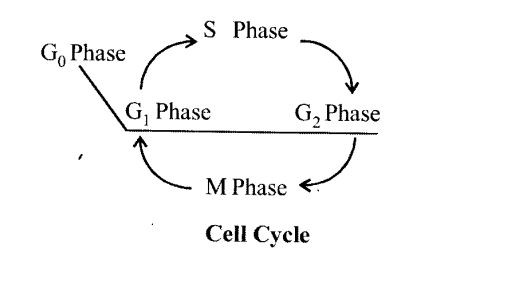
A cell in this stage remains metabolically active but no longer proliferate unless called to do so depending on the requirement of the organism.
Question 5.
Why is mitosis called equational division?
Solution:
M phase is the most dramatic period of the cell cycle involving a major reorganization of virtually all components of the cell. Since the number of chromosomes in the parent and progeny cells is the same it is also called equational division. Though for convenience mitosis has been divided into four stages of nuclear division, it is very essential to understand that cell division is a progressive process and very clear-cut lines cannot be drawn between various stages.
Mitosis is divided into the following four stages:
- Prophase
- Meta phase
- Anaphase
- Telophase
Question 6.
Name the stage of the cell cycle at which one of the following events occur:
i. Chromosomes are moved to the spindle equator.
ii. Centromere splits and chromatids separate.
iii. Pairing between homologous chromosomes takes place.
iv. Crossing over between homologous chromosomes takes place.
Solution:
i. Metaphase
ii. Anaphase II
iii. Zygotene
iv. Pachytene
Question 7.
Describe the following:
(a) synapsis
(b) bivalent
(c) chiasmata
Draw a diagram to illustrate your answer.
Solution:
(a) During zygotene of prophase I of meiosis homologous chromosomes pair together. This pairing is called synapsis.

(b) Bivalent: The complex formed by homologous chromosomes during zygotene is called a bivalent.
(c) Chiasmata: During diplotene, the paired chromosomes make an X-shaped structure. This is called chiasmata.
Question 8.
How does cytokinesis in plant cells differ from that in animal cells?
Solution:
In animal cells, cytokinesis is achieved by the appearance of a furrow in the plasma membrane. The furrow gradually deepens and ultimately joins in the centre dividing the cell cytoplasm into two.
Due to the presence of cell walls, cytokinesis is different in plants. In plants, wall formation starts in the centre of the cell and grows outward to meet the existing lateral walls. The formation of the new cell wall begins with the formation of a simple precursor, called the cell plate that represents the middle lamella between the walls of two adjacent cells. Organelles like mitochondria and plastids get distributed between the two daughter cells during this process.
Question 9.
Find examples where the four daughter cells from meiosis are equal in size and where they are found unequal in size.
Solution:
The four daughter cells produced may be equal in size in the sperm of animals. They may be unequal in size as gametes in plants-pollen grains and egg in ovules.
Question 10.
Distinguish anaphase of mitosis from anaphase I of meiosis.
Solution:
The main difference between anaphase of mitosis and anaphase I of meiosis are as follows:
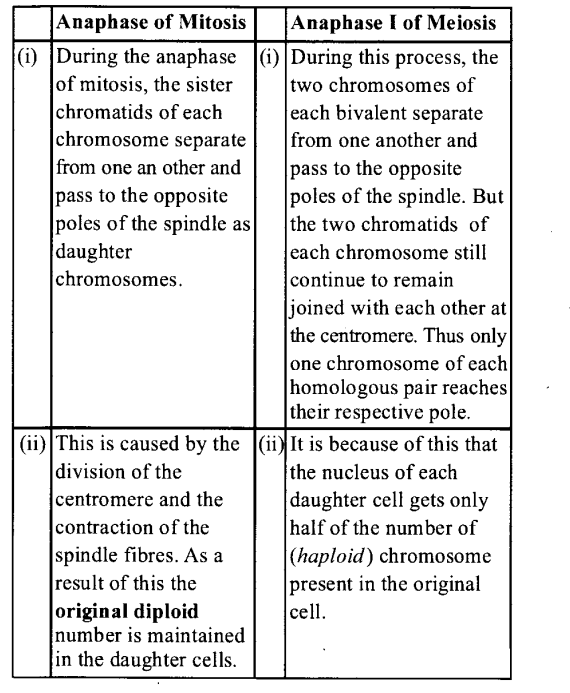
Question 11.
List the main differences between mitosis and meiosis.
Solution:
The main differences between mitosis and meiosis are as follows :
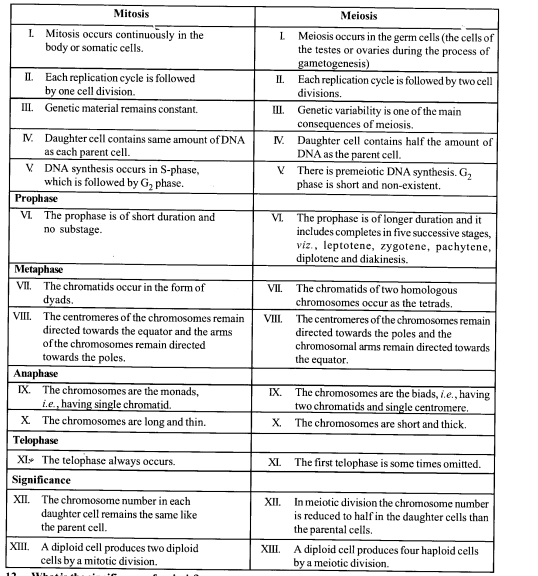
Question 12.
What is the significance of meiosis?
Solution:
1. Meiosis ensures the production of the haploid phase in the life cycle of sexually reproducing organisms whereas fertilization restores the diploid phase. We come across meiosis during gametogenesis in plants and animals. This lead to the formation of haploid gemotes.
2. Crossing over takes place during the Pachytene stage of meiosis, in which an exchange of genetic matter occurs. This produces variation, the raw material for evolution.
3. Meiosis has an impact on the genetic consequences due to pairing, crossing over, recombination, and segregation of homologous chromosomes.
Question 13.
Discuss with your teacher about
- haploid insects and lower plants where cell-division occurs and
- some haploid cells in higher plants where cell-division does not occur.
Solution:
- Some insects like honey bee drones are haploid. They are not fertile.
- In lower plant, main plant body is haploid produces haploid microspores by mitosis. The gametes of Chlamydomonas fuse to form diploid zygotes. Meiosis take place at this stage in lower plants forming haploid spous which give rise to the new plant.
Question 14.
Can there be mitosis without DNA replication in S-phase?
Solution:
S or synthesis phase marks the period during which DNA synthesis or replication takes place. During this time the amount of DNA per cell doubles. If the initial amount of DNA is denoted as 2C then it increases to 4C. However, there is no increase in the chromosome number; if the cell had diploid or 2n number of chromosomes at G, even after the S phase the number of chromosomes remains the same i.e. 2n.
Question 15.
Can there be DNA replication without cell division?
Solution:
DNA replication takes place in order to prepare cells for division. Cell division is the next logical step after DNA replication.
Question 16.
Analyze the events during every stage of the cell cycle and notice how the following two parameters change
i. Number of chromosomes (N) per cell
ii. Amount of DNA content (C) per cell
Solution:
Cell division is a very important process in all living organisms. During the division of a cell, DNA replication and cell growth also take place. Although cell growth is a continuous process, DNA synthesis occurs only during one specific stage in the cell cycle. The replicated chromosomes (DNA) are then distributed to daughter nuclei by a complex series of events during cell division. These events are themselves under genetic central.
The cell cycle is divided .nto two basic phases: The M phase starts with the nuclear division, corresponding to the separation of daughter chromosomes (Kaiyokinesis), and usually ends with the division of cytoplasm (Cytokinesis’). The interphase though called the resting phase is the time during which the cell is preparing for division by undergoing both cell growth and DNA replication in an orderly manner. The interphase is divided into three further phases:
- G1 phase (Gap)
- S phase (Synthesis)
- G2 phase (Gap2)
VERY SHORT ANSWER QUESTIONS
Question 1.
What is karyokinesis?
Solution:
Division of nucleus is Known as karyokinesis.
Question 2.
Name the phase in which chromatids move apart.
Solution:
Anaphase.
Question 3.
Name the synthetic phase of interphase.
Solution:
S phase
Question 4.
Name the cell divisions which help recombination of genes.
Solution:
Meiosis.
Question 5.
Which type of cell division occurs in the meristematic cell of the root apex?
Solution:
Mitosis
Question 6.
Name the stage during which astral and spindle fibres disappear and nuclear membrane and nucleoli reappear.
Solution:
Telophase.
Question 7.
Name the sub-phases of prophase-I of Meiosis.
Solution:
Leptotene, Zygotene, Pachytene, Diplotene and Diakinesis.
Question 8.
In which stage, the actual reduction of chromosome number occurs in meiosis?
Solution:
Anaphase I
Question 9.
What is Synapsis? (Bijapur, Belgaum, Shimoga 2004)
Solution:
The process of pairing homologous chromosomes is called Synapsis.
Question 10.
What is the peculiarity of zygotene?
Solution:
In the zygotene phase pairing of homologous chromosomes or synapsis takes place.
Question 11.
Define crossing over. Give its significance.
Solution:
It is an exchange of genes between non-sister chromatids of homologous chromosomes. It produces new combination of genes and variation.
Question 12.
Why mitosis is an equational division called?
Solution:
Mitosis is a process of cell division, in which chromosomes are equally distributed into two daughter cells so it is equational division.
SHORT ANSWER QUESTIONS
Question 1.
Differentiate between:
(a) S-phase and G2 phase.
(b) G1 and G2 phase
Solution:
(a) Difference between S-phase and G2 phase:
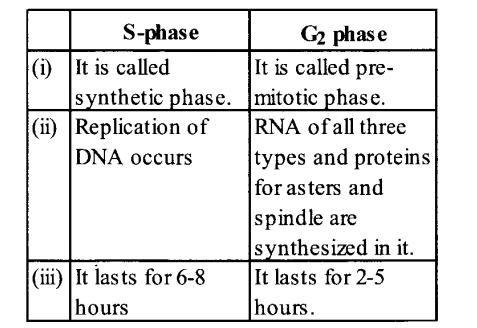
(b) Difference between Gj and G2 phase
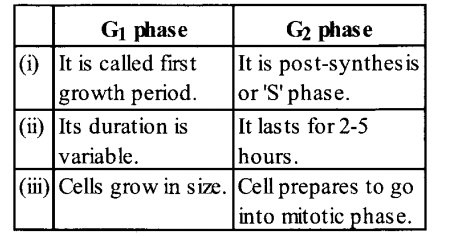
Question 2.
Write the significance of Mitosis / Meiosis. (Udupi 2006, D.Kannada 2010)
Solution:
Significance of Mitosis:
- The distribution of an equal number of chromosomes to the daughter cells maintains a constant chromosome number.
- Mitosis increases the number of cells so it contributes to growth.
Significance of Meiosis:
- Meiosis brings genetic crossing over and random distribution of paternal and maternal chromosomes to daughter cells.
- Recombination produces variations and variations are the sources of organic evolution.
Question 3.
Mention the significance of mitosis.
Solution:
- In multicellular organisms, the growth of the body is due to the mitotic division of cells.
- Replacement of worn-out cells and repair of the damaged cells is by mitosis.
- In unicellular organisms, mitosis results in the asexual reproduction of cells.
- In plants, vegetative propagation involves only mitotic divisions.
Question 4.
When and why does a reduction in the number of chromosomes take place in meiosis?
Solution:
The actual reduction in the number of chromosomes takes place in anaphase I.
This is because in anaphase I, one member from each homologous pair moves to one pole; the two chromatids of the chromosomes do not separate as the centromeres do not divide at this stage.
Question 5.
Differentiate between prophase I and prophase of mitosis.
Solution:
Difference between prophase I and prophase of mitosis are :
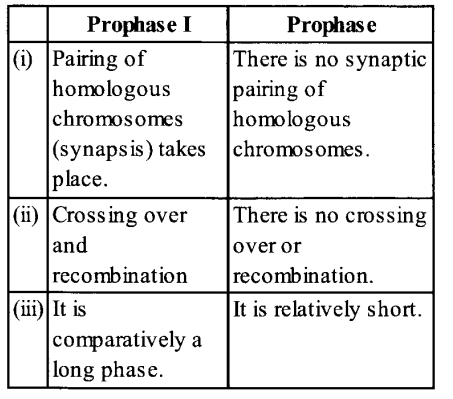
Question 6.
Imagine a situation if there was no meiosis. Then what would have happened to the next generation?
Solution:
In the absence of meiosis, the next generation would have double the number of chromosomes after the fusion of gametes. This would have resulted in the birth of an altogether new species. The maintenance of characters’ sets would have been possible only through asexual reproduction.
Question 7.
Which stage in meiosis is marked with genetic recombination? How
Solution:
In the pachytene stage of meiosis I the chromosomes appear as tetrads of homologous chromosomes and cross as the genetic material exchange takes place. Thus this stage is marked with genetic recombination.
Question 8.
What is Synapsis and Synaptonemal Complex? In which stage do these occur?
Solution:
The pairing of chromosomes is called Synapsis.
In the chromosomal synapsis, a complex structure is made known as the Synaptonemal complex These occur in the zygotene stage of meiosis.
Question 9.
Describe the events in the prophase of animal cells.
Solution:
- Chromosomal material condenses to form compact mitotic chromosomes.
- Chromosomes are seen to be composed of two chromatids attached together at the centromere.
- The centrioles formed in interphase start moving to the opposite poles of the cell.
- Initiation of the assembly of the mitotic spindle, the microtubules, the proteinaceous components of the cell cytoplasm help in the process.
- By the end of the prophase, the nuclear membrane and nucleolus disappear.
Question 10.
Diagrammatically shows the cell cycle and answers the following questions.
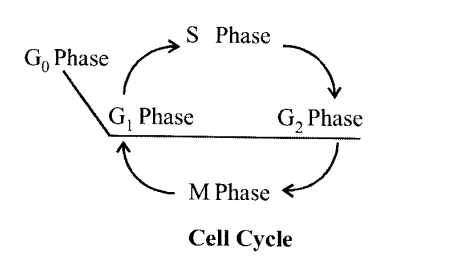
(a) Which is the resting stage.
(b) Which is the stage where replication takes palce.
(c) Which is the stage where mitosis takes place.
(d) Which is the post cell synthetic but pre-cell division stage.
Solution:
(a) Go Phase
(b) S Phase
(c) M Phase
(d) G2 Phase
Question 11.
Define cytokinesis. How is it accomplished in animal and plant cells?
Solution:
The process by which the cytoplasm of the cell divides resulting in the formation of two daughter nuclei is called cytokinesis.
In an animal cell, this is achieved by the appearance of a furrow in the plasma membrane. The furrow gradually deepens and ultimately joins in the centre dividing the cell cytoplasm into two.
In-plant cells, wall formation starts in the centre of the cell and grows outward to meet the existing lateral walls. The formation of a new cell wall begins with the formation of a simple precursor, called the cell plate that represents the middle lamella between the walls to two adjacent cells.
LONG ANSWER QUESTIONS
Question 1.
Describe briefly cytokinesis in animal cells and plant cells.
Solution:
(a) Cytokinesis in animal cells: In the animal cells, the cytoplasm divides by constriction. It appears on the equator and slowly deepens. The constriction converges on all the sides and pinches off the parent cell into 2 daughter cells. Constriction is the result of a peripheral band of microfilaments. This constriction divide the cytoplasm finally,
(b) Cytokinesis in plant cells: Plant cells have a rigid cell wall and this cannot undergo cytokinesis by invaginating cleavage furrow. Therefore, in them, the cytokinesis is accomplished by the formation of phragmoplast from carbohydrate and lipid-containing vesicles of Golgi apparatus and endoplasmic reticulum vesicles. A cell plate at the equator of the dividing cell is formed and divides the cytoplasm.
Question 2.
Mention the significance of mitosis.
Solution:
Significance of mitosis: Mitosis or the equational division is usually restricted to the diploid cells only.
- However, in some lower plants and in some social insects haploid cells also divide by mitosis.
- It is very essential to understand the significance of this division in the life of an organism.
- Mitosis results in the production of diploid daughter cells with identical genetic complement usually.
- The growth of multicellular organisms is due to mitosis. Cell growth results in disturbing the ratio between the nucleus and the cytoplasm.
- It, therefore, becomes essential for the cell to divide to restore the nucleo- cytoplasmic ratio. A very significant contribution to mitosis is cell repair.
- The cells of the upper layer of the epidermis, cells of the lining of the gut, and blood cells are being constantly replaced.
- Mitotic divisions in the meristematic tissues – the apical and the lateral cambium, result in the continuous growth of plants throughout their life.
Question 3.
Describe meiosis II with the help of suitable diagrams.
Solution:
Meiosis II is divided into four phases.
Prophase II. Meiosis II is initiated immediately after cytokinesis, usually, before the chromosomes have fully elongated. In contrast to meiosis I, meiosis II resembles a normal mitosis. The nuclear membrane disappears by the end of prophase II. The chromosomes again become compact.
Metaphase II- At this stage, the chromosomes align at the equator and the microtubules from opposite poles of the spindle get attached to the kinetochores of sister chromatids. Anaphase II- It begins with the simultaneous splitting of the centromere of each chromosome (which was holding the sister chromatids together), allowing them to move toward opposite poles of the cell.
Telophase II- Meiosis ends with telophase II, in which the two groups of chromosomes once again get enclosed by a nuclear envelope; cytokinesis follows resulting in the formation of a tetrad of cells i.e., four haploid daughter cells.
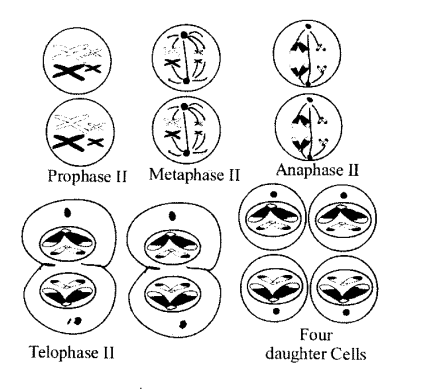
We hope the NCERT Solutions for Class 11 Biology at Work Chapter 10 Cell Cycle and Cell Division, help you. If you have any query regarding NCERT Solutions for Class 11 Biology at Work Chapter 10 Cell Cycle and Cell Division, drop a comment below and we will get back to you at the earliest.

